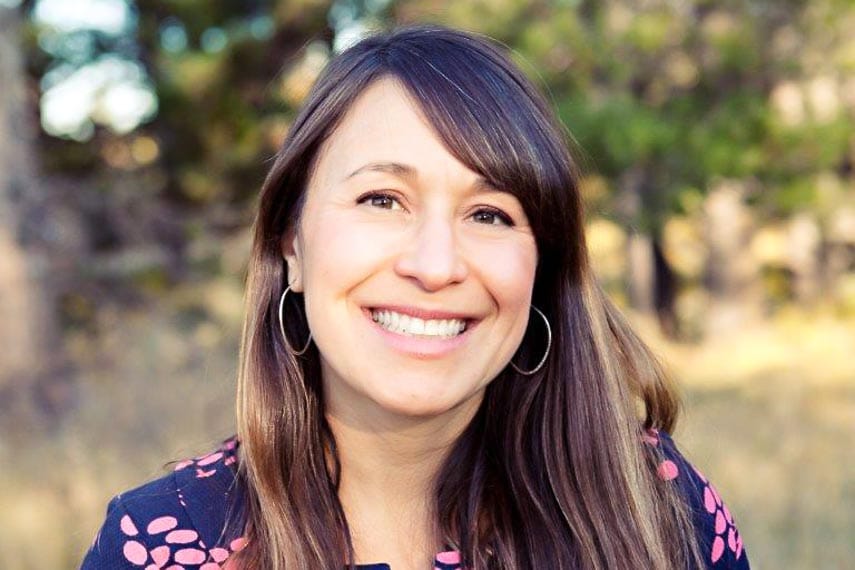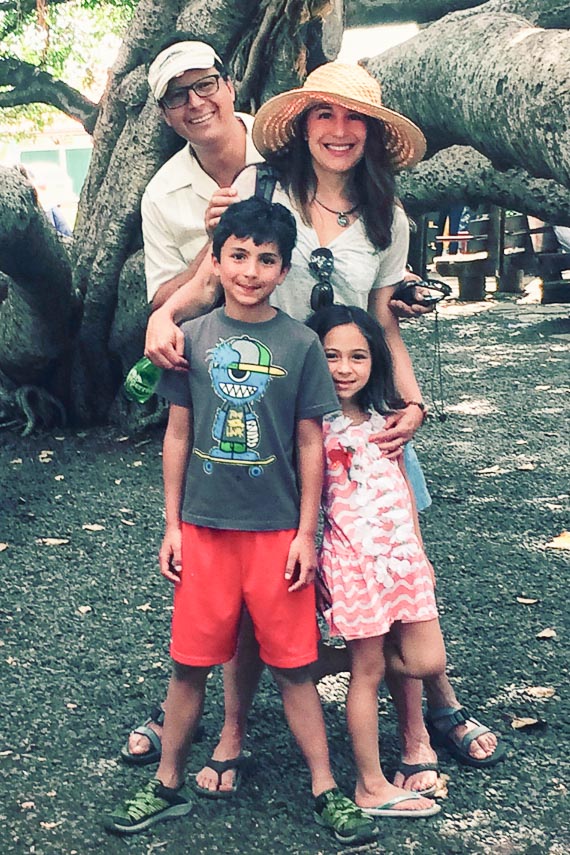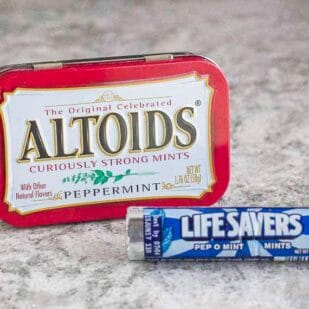Meet Vanessa Vargas RDN
Vanessa Vargas RDN has joined our Success Team of registered dietitians. She has completed the Monash University training for the low FODMAP diet, maintains her own private practice and a blog called MyFODMAPFriend.com and practices as a GI RDN at an outpatient clinic.
She has battled IBS and SIBO herself so she knows all too well what so many of us are dealing with and she brings compassion, empathy and a deep knowledge of the low FODMAP diet to her consulting and articles.
You can see her work on FODMAP Everyday® where she has reviewed the Monash Training course and has created two amazing shopping lists (so far!), one for THRIVE Market and one for Trader Joe’s. You might also recognize her name from being a moderator on the Low FODMAP Recipes & Support Facebook Group. Her bio can be found here!
Dédé Wilson: Vanessa, we are so excited that you are now part of the FODMAP Everyday® Success Team. As you know we are working towards having all of our RDs complete the Monash Training – and when we come across someone like you who has the low FODMAP knowledge as well as personal experience, it is a very powerful combination.
Tell us a little about how you became a dietitian in the first place and also a bit about your own journey learning about your own IBS.
Vanessa Vargas: From a young age of 16 I knew I wanted to be a dietitian. This career path stemmed from an obsession with nutrition. To be honest, this nutrition obsession was initially not so healthy, I suffered from bulimia and flirted with anorexia in my teen years and early 20s.
My diet was very restrictive, virtually fat free, and excessive in artificial sweeteners for many years, which I truly believe contributed to my GI dysfunctions.
Looking back I probably had IBS around this time which likely added fire to my eating disorder especially when you experience bloating after eating an apple. Several years ago researchers at the University of Sydney noted a significant increase in GI consequences from a fructose-sorbitol challenge in those with an eating disorder in comparison to healthy individuals.
My IBS diagnosis was given to me at age 22 and the only recommendation I recall from my MD was to eat more fiber, which can make symptoms worse based on the fiber type consumed. Over the years I tried many over the counter fiber supplements, herbal supplements, and numerous diets with no relief.
Vanessa, thank you for being so open about your early relationship with food. I have never been able to thoroughly piece together some of my own eating issues from my teens and early 20s and what I have experienced as an adult. Back then I was 92 pounds, thought I was fat and had a binge and starve cycle going for many years. Even at such a low weight, I had a belly pooch, most likely due to IBS, as I realize in retrospect that I had many of the symptoms and it led to my body dysmorphic issues.
(Body Dysmorphic Disease or BBD is characterized by a person obsessing over real, or very often, perceived flaws). I think it really helps others to hear stories – because as you and I know, all of you who are reading this, we are here to tell you that you are not alone in your struggles!
I am so grateful that my personal struggles led me to this career path, I truly love what I do. Over the past 18 years I have been an inpatient clinical dietitian, ASPEN certified nutrition support clinician and an outpatient dietitian specializing in medical and surgical weight loss, IBS, SIBO and IBD.
You have worked extensively with patients who undertake surgical weight loss procedures or at the very least, intensive medical intervention for their weight issues. Have you had any patients where a FODMAP issue overlapped? How do you deal with that?
Yes, I have had patients present with IBS who also sought weight loss. If IBS symptoms are severe and not well managed my first step would be getting their IBS under better control with the low FODMAP diet. It can be very challenging to work on both at the same time.
General recommendations such as practicing portion control, avoiding large meals, eating at regular times, mindful eating, consuming adequate fluid, and regular exercise can be beneficial for those suffering from IBS and weight issues.
For my surgical weight loss patients I have limited preoperative nutrition visits and have so much to cover therefore I tailor this education to be more FODMAP friendly while providing suggestions on low FODMAP protein shakes, vitamins, and supplements, which are important after surgery.
Several of my bariatric patients with IBS stated improvement in their IBS symptoms after surgery.
The gastric bypass and sleeve gastrectomy have both been shown to improve one’s gut bacteria to favor a better microbial diversity (more bacteroidetes and less firmicutes bacteria) in relation to obesity, however, there is insufficient evidence on how these surgeries affects IBS.
Several factors and side effects of bariatric surgery such as dumping syndrome, fat malabsorption, and diarrhea secondary to increased intake of sugar alcohols (often found in sugar-free chewable vitamins, minerals and supplements) mimic IBS symptoms which can make it harder to discern IBS or food intolerance.
Also, we know you have experience with tube feeding (enteral nutrition). Obviously for the average person, this isn’t something that they think about, but for some, this is the only food they can have. Can you tell us a little about when and why that is the case?
While this might not be FODMAP related it will give us some insight into your breadth of expertise.
A person may require tube feeding for a variety of medical conditions such as dysphagia (difficulty swallowing), which can occur after a stroke or radiation therapy for head and neck cancers, severe gastroparesis, and ALS (amyotrophic lateral sclerosis) to name a few.
I also worked with pediatrics on tube feeding for conditions such as FTT (failure to thrive), cerebral palsy, severe reflux, and various metabolic syndromes.
Many prebiotic fibers such as FOS (fructo-oligosaccharides) are added to tube feeding formulas which are high FODMAP and promote the growth of beneficial bacteria in the large intestines. If a patient complained of excessive bloating or gas I would consider a trial with a formula without fiber or a different fiber source.
Looking back the FOS was possibly the culprit. As a nutrition support RDN I provided home visits where I taught my patient and their caregivers how to administer the tube feed. I then followed these patients on a regular basis to ensure they were tolerating their tube feeding regimens and meeting their nutritional needs.
Back to FODMAPs. When you first discovered the diet, did you immediately apply it to yourself? And how did you discover it, by the way?
My first introduction to the low FODMAP concept was an article in Today’s Dietitian in 2014. While reading about high FODMAP foods I had one of those aha moments, so many of these foods were my food triggers that I discovered over the years. My first book on this subject was IBS-Free at Last! by Patsy Catsos MS, RD, LD (see our interview with Patsy here) and the title was perfect, finally I felt free from bad belly days.
As a RDN the FODMAP concept made sense, however, it took me 6 months or longer to initiate. To be honest I was tired of diets and it seemed a bit daunting trying to balance this while still finding time to cook for my family and work full time. When I finally embraced the diet and completed the Elimination phase (with many errors) I felt so much better.
What I mean by errors is that I was not very careful about portion sizes or avoiding foods with natural flavors. I would often eat too many low FODMAP vegetables at one meal, which we refer to as stacking and this would often result in an IBS flare. I have now learned that natural flavors on a label can contain a high FODMAP ingredient and are not encouraged during elimination unless verified safe.
The low FODMAP diet helped me greatly for about a year but I got to a point where my symptoms started to return to a lesser degree and my FODMAP thresholds were lowered. It was time to get help; I opted to meet with both a naturopath and GI physician to compare notes from both eastern and western medicine regarding this topic.
Both suspected SIBO, which was also on my radar. The home lactulose breath test showed positive, however, my results were not typical. My hydrogen levels started off at 56 and climbed to 156 by the end of the 2-hour breath test. A rise of 20ppm in hydrogen indicates SIBO.
After 2 rounds of Rifaximin, probiotics and an herbal antibiotic my symptoms finally improved. The Challenge phase was equally challenging and scary, I did not want to test foods and induce symptoms.
This was me too! I had finished the Elimination phase and was feeling so great that I didn’t want to rock the boat – and my wedding was coming up. Luckily I was working with Kate Scarlata at the time on our book and shared my fears with her. She told me to wait till after the wedding to begin the Challenge phase, which made so much sense.
Eventually I did a cautious reintroduction and am now aware of my triggers, safe thresholds and how to live on an adapted low FODMAP diet. Since my Monash training I have been inspired to repeat the Elimination and Challenge phase which is encouraged after 6 months, this is long overdue.
For the first time in a very long time I do not want to get into my PJs as soon as I got home. I wear clothes that are more flattering. Visceral sensitivity and bloating are two of my main symptoms and tight clothing can be so uncomfortable.
My anxiety around food is greatly diminished and for the first time in close to two decades I feel in control of my IBS. I have became very good at keeping my FODMAP bucket (my favorite concept from Patsy Catsos MS, RD) low enough to keep bad belly days away.
Vanessa, I am nodding in recognition here. I wore elastic waist pants for years and it is still a hard habit to break – but I bought my first jeans in decades after the Challenge phase and was amazed I could wear something around my belly without pain.
Were your early experiences with the diet fruitful for you personally? How about professionally?
This diet has been life changing for me, both personally and within my career. The low FODMAP diet has kept my IBS and SIBO symptoms under good control. My personal low FODMAP journey and several FODMAP webinars gave me the confidence to start teaching the low FODMAP diet.
After several presentations to the doctors and gaining 100% support from the GI providers I established a great referral base.
My counseling skills and education materials continue to evolve as the science around low FODMAP continues to grow. My goal is to learn everything I can on how to build a better gut garden for not only myself but also for my patients.
The microbiome is an emerging field, which is closely related to IBS and SIBO. In the past few years the low FODMAP diet has exploded but we still have more work to do.
Last survey I saw showed that only 24% of IBS sufferers are familiar with this diet. It has been amazing to see all the support around this diet which I so enjoy being a part of.
What are some of the most difficult parts of the diet that you see with your patients and how do you help them overcome these obstacles?
Interpreting a food label to determine if a product is high or low in FODMAPs is a challenge for many. I provide educational materials to help one understand what are safe ingredients and often encourage one to avoid if in doubt. I always encourage my patients to follow up with me via email and send me a picture of a product if they are uncertain.
One of my favorite Facebook groups I help moderate is USA Low FODMAP Products which is a great place to search for safe low FODMAP food products. The concept of FODMAP stacking is also challenging to teach.
My advice is to choose more foods with no FODMAPs detected and limit foods with defined serving sizes. Often via email communication I provide them a link to our article to help explain this concept at a later time.
You recently shared your trip to Hawaii with us and others on social media. Tell us about traveling while following the low FODMAP diet. Did you have some exciting discoveries? Have any travel tips for us?
Traveling on the low FODMAP can be challenging but is definitely possible. Often my belly does better on vacation since my stress levels are down and I am more active. Often times we stay at hotels or condos with a kitchen where I can control several of my meals.
Rolled oats, NuCo coconut wraps, favorite tea bags, and safe nuts are my staples that I bring from home. I had so much fun searching for low FODMAP foods to share with fellow low FODMAPPers on social media.
If I was alone I could spend hours in the grocery store aisles looking for new low FODMAP foods, hence my chosen task to curate low FODMAP shopping lists.
Hawaiian farmers markets are my favorite and this time in Kauai I found mangosteens, rambutans, and longans, which are all safe in small portions. My meals are often based around whole food like oats, potatoes, rice, low FODMAP fruits and vegetables, and proteins.
I try to keep my FODMAP bucket low so there is some room to include small portions of high FODMAP foods and ingredients.
Alcohol does not often agree with me and over time I have decided my belly is much happier if this is kept to a minimum. Exercise is something I strive for most days when traveling, this keeps me sane, fit, and provides me some much-needed alone time.
And tell us why you call yourself a “fermenter” in your blog’s bio? We want to know what you are cooking up in your kitchen – and did you need to alter anything once you started FODMAPing?
Probiotics fascinate me, there is still so much to learn in this field and we are just scratching the surface. It is not advised to be on the low FODMAP diet for longer than 2 to 3 months since it can reduce healthy bifida bacteria.
Much of the nutrition around improved gut health encourages one to push their prebiotic threshold and include probiotic rich foods.
A recent experiment I read in a nutrition magazine demonstrated that kefir contained 27.7 billion CFU, yogurt 3.6 billion CFU, and kombucha 23.1 millions CFU per 1 cup (240 ml) serving. Research has shown that some probiotic strains may improve IBS symptoms.
I always encourage my patients to incorporate lactose free yogurts and kefirs versus adding probiotics unless they are already taking them per doctor recommendations during Elimination. Fermenting my own yogurts, water kefirs, and kombucha has been very rewarding and much cheaper than store bought options. I have perfected lactose free yogurt and water kefir.
Kombucha and sourdough bread are still a work in progress. After my recent trip to Hawaii I am fascinated with poi, which is fermented taro root, guessing this may be hard to locate in Bend, OR. Your tip about keeping a green onion in a jar of water on the windowsill is by far my favorite, mine continue to thrive even through a cold winter.
I truly enjoy cooking, trying new recipes, and having small dinner parties. After 20 years I have finally realized that no one wants to invite a RDN over to dinner, especially one on a low FODMAP diet. I am kinda kidding, but not really. I am guessing it is the same for you?
Yup! Some of my friends who have known me from me pre-cookbook author days look at me as just a regular person, which of course I am, but others get intimidated and literally fear cooking for me, which is so silly, because I love to be cooked for!
Cooking for a chef is super intimidating. Most of my friends are vegetarians, which is a dietary pattern I very much enjoy and can easily accommodate. Another amazing tip from the Microbiome Solution book by Robynne Chutkan is to follow the 1-2-3 rule.
Eat 1 vegetable with breakfast, 2 with lunch, and 3 with dinner – this is my personal goal and often achievable. Plant based fibers are so important in all stages of the low FODMAP diet.
Vanessa, thank you so much for the interview and for all the great work you do helping people heal through food – especially when navigating the low FODMAP diet!
Thank you Dédé and Robin for accepting me into your amazing Success Team. I am excited for our future projects, articles, and more. This low FODMAP journey is so much more fun with you.









